2016 MERCEDES-BENZ GL park assist
[x] Cancel search: park assistPage 18 of 462

Opening/closing the roller sun-
blind ............................................... 105
Problem (malfunction) .................. .1 06
Resetting ....................................... 105
Parking
Important safety notes .................. 189
Parking brake ................................ 190
Position of exterior mirror, front-
passenger side ............................... 126
Rear view camera .......................... 231
see PARKTRONIC
Parking aid
Active Parking Assist ..................... 227
see Exterior mirrors
see PARKTRONIC
Parking assistance
see PARKTRONIC
Parking brake
Display message ............................ 294
Electric parking brake .................... 190
Warning lamp ................................. 333
Parking lamps
Switching on/off ........................... 131
PARKTRONIC
Deactivating/activating ................. 226
Driving system ............................... 224
Function/notes ............................ .2 24
Important safety notes .................. 224
Problem (malfunction) ................... 227
Range of the sensors ..................... 224
Trailer towing ................................. 226
Warning display ............................. 225
PASSENGER AIR BAG
Display message ............................ 301
Problems (malfunction) .................. 301
PASSENGER AIR BAG OFF
Indicator lamp .................................. 45
Pets in the vehicle ............................... 67
Plastic trim (cleaning instruc-
tions) .................................................. 382
Power closing feature ......................... 92
Power washers .................................. 377
Power windows
see Side windows
PRE-SAFE ®
(anticipatory occupant
protection)
Display message ............................ 297 Operation ......................................... 60
PRE-SAFE ®
Brake
Activating/deactivating ................. 282
Display message ............................ 298
Function/notes ................................ 76
Important safety notes .................... 76
Warning lamp ................................. 337
Program selector button .................. 177
Protection against thef t
ATA ( Anti-Theft Alarm system) ......... 78
Immobilizer ...................................... 78
Protection of the environment
General notes .................................. 24
Pulling away
General notes ................................ 168
Trailer ............................................ 168
Pulling away (automatic transmis-
sion) .................................................... 168
Q QR code
Mercedes-Benz Guide App ................. 1
Rescue card ..................................... 30
Qualified specialist workshop ........... 29
R
RACETIMER (on-board computer) .... 288
Radiator cover ................................... 371
Radio
Selecting a station ......................... 278
see separate operating instructions
Radio-wave reception/transmis-
sion in the vehicle
Declaration of conformity ................ 28
Reading lamp ..................................... 135
Rear bench seat
Folding forwards/back .................. 344
Rear compartment
Exit/entry position (3rd row of
seats) ............................................. 115
Setting the air vents ...................... 161
Setting the temperature ................ 155
Rear fog lamp
Display message ............................ 304
Switching on/off ........................... 13116
Index
Page 23 of 462
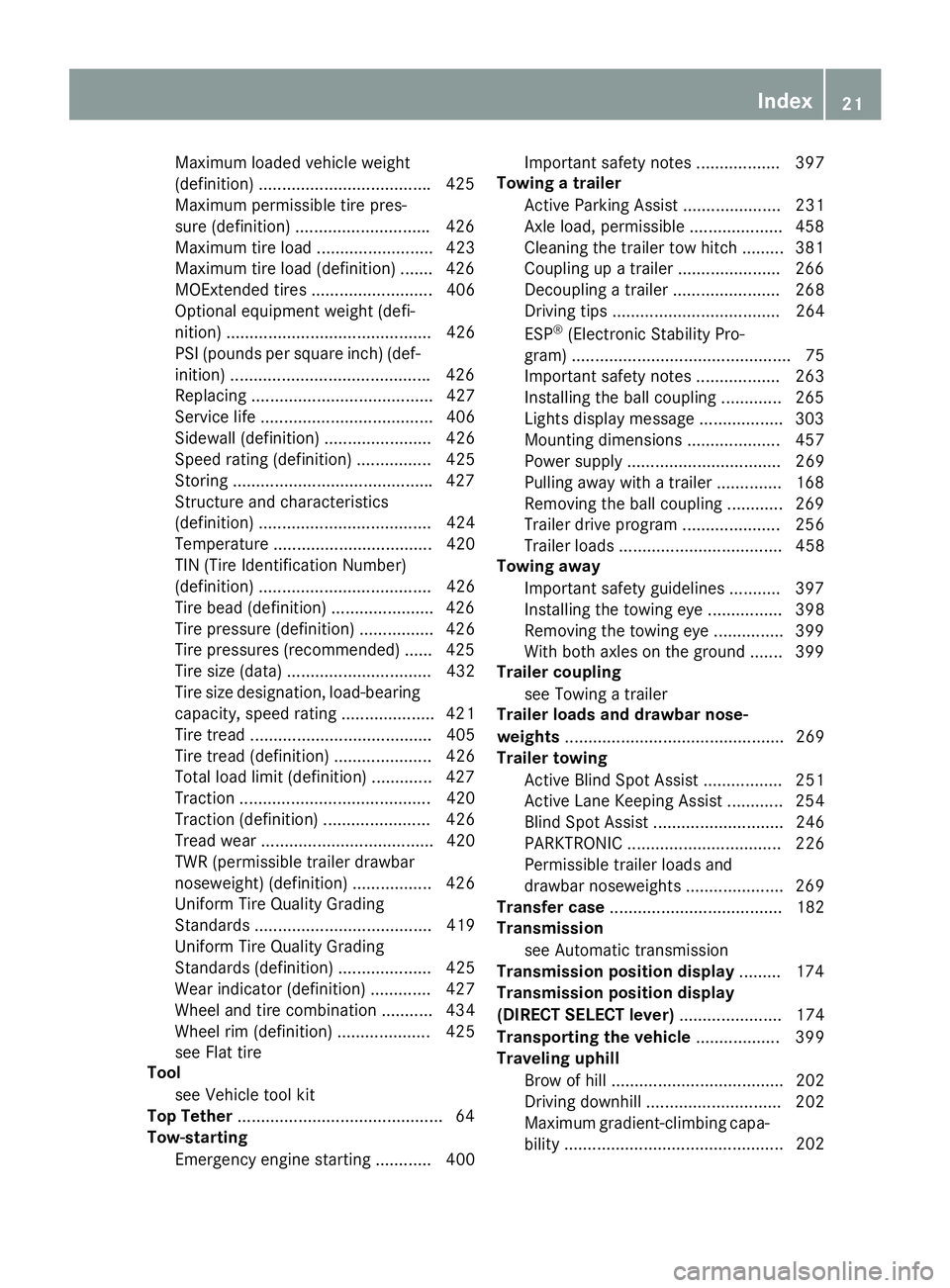
Maximum loaded vehicle weight
(definition) .................................... .4 25
Maximum permissible tire pres-
sure (definition) ............................ .4 26
Maximum tire load ......................... 423
Maximum tire load (definition) ....... 426
MOExtended tires .......................... 406
Optional equipment weight (defi-
nition) ............................................ 426
PSI (pounds per square inch) (def-
inition) .......................................... .4 26
Replacing ....................................... 427
Service life ..................................... 406
Sidewall (definition) ....................... 426
Speed rating (definition) ................ 425
Storing .......................................... .4 27
Structure and characteristics
(definition) ..................................... 424
Temperature .................................. 420
TIN (Tire Identification Number)
(definition) ..................................... 426
Tire bead (definition) ..................... .4 26
Tire pressure (definition) ................ 426
Tire pressures (recommended) ...... 425
Tire size (data) ............................... 432
Tire size designation, load-bearing
capacity, speed rating .................... 421
Tire tread ....................................... 405
Tire tread (definition) ..................... 426
Total load limit (definition) ............. 427
Traction ......................................... 420
Traction (definition) ....................... 426
Tread wear ..................................... 420
TWR (permissible trailer drawbar
noseweight) (definition) ................. 426
Uniform Tire Quality Grading
Standards ...................................... 419
Uniform Tire Quality Grading
Standards (definition) .................... 425
Wear indicator (definition) ............. 427
Wheel and tire combination ........... 434
Wheel rim (definition) .................... 425
see Flat tire
Tool
see Vehicle tool kit
Top Tether ............................................ 64
Tow -s
tarting
Emergency engine starting ............ 400 Important safety notes .................. 397
Towing a trailer
Active Parking Assist ..................... 231
Axle load, permissible .................... 458
Cleaning the trailer tow hitch ......... 381
Coupling up a trailer ...................... 266
Decoupling a trailer ....................... 268
Driving tips .................................... 264
ESP ®
(Electronic Stability Pro-
gram) ............................................... 75
Important safety notes .................. 263
Installing the ball coupling ............. 265
Lights display message .................. 303
Mounting dimensions .................... 457
Power supply ................................. 269
Pulling away with a trailer .............. 168
Removing the ball coupling ............ 269
Trailer drive program ..................... 256
Trailer loads ................................... 458
Towing away
Important safety guidelines ........... 397
Installing the towing eye ................ 398
Removing the towing eye ............... 399
With both axles on the ground ....... 399
Trailer coupling
see Towing a trailer
Trailer loads and drawbar nose-
weights ............................................... 269
Trailer towing
Active Blind Spot Assist ................. 251
Active Lane Keeping Assist ............ 254
Blind Spot Assist ............................ 246
PARKTRONIC ................................. 226
Permissible trailer loads and
drawbar noseweights ..................... 269
Transfer case ..................................... 182
Transmission
see Automatic transmission
Transmission position display ......... 174
Transmission position display
(DIRECT SELECT lever) ...................... 174
Transporting the vehicle .................. 399
Traveling uphill
Brow of hill ..................................... 202
Driving downhill ............................. 202
Maximum gradient-climbing capa-
bili ty ............................................... 202 Index 21
Page 72 of 462

As a result, BAS PLUS may not intervene in all
critical situations. There is a risk of an acci-
dent.
Always pay careful attention to the traffic sit-
uation and be ready to brake.
In the event of snowfall or heavy rain, the rec-
ognition can be impaired.
Recognition by the radar sensor system is
also impaired in the event of: R
there is dirt on the sensors or anything else
covering the sensors R
there is interference by other radar sources R
there are strong radar reflections, for
example in parking garages R
a narrow vehicle traveling in front, e.g. a
motorbike R
a vehicle traveling in front on a different line
relative to the center of your vehicle
Following damage to the front end of the vehi-
cle, have the configuration and operation of
the radar sensors checked at a qualified spe-
cialist workshop. This also applies to colli-
sions at low speeds where there is no visible
damage to the front of the vehicle.
Function
To avoid a collision, BAS PLUS calculates the
brake force necessary if: R
you approach an obstacle, and R
BAS PLUS has detected a risk of collision
When driving at a speed under 20 mph
(30 km/h) : if you depress the brake pedal,
BAS PLUS is activated. The increase in brake
pressure will be carried out at the last possi-
ble moment.
When driving at a speed above 20 mph
(30 km/h) : if you depress the brake pedal
sharply, BAS PLUS automatically raises the
brake pressure to a value adapted to the traf-
fic situation.
BAS PLUS provides braking assistance in haz-
ardous situations with vehicles in front within a speed range between 4 mph (7 km/h) and
155 mph (250 km/h).
At speeds of up to approximately 40 mph
(70 km/h), BAS PLUS can also react to sta-
tionary objects. Examples of stationary
objects are stopped or parked vehicles.
i If BAS PLUS demands particularly high
braking force, preventative passenger pro-
tection measures (PRE-SAFE ®
) are activa-
ted simultaneously. X
Keep the brake pedal depressed until the
emergency braking situation is over.
ABS prevents the wheels from locking.
BAS PLUS is deactivated and the brakes func-
tion as usual again, if: R
you release the brake pedal. R
there is no longer a risk of collision. R
no obstacle is detected in front of your
vehicle.
If you have activated DSR ( Y
page 257), BAS
PLUS is likewise deactivated.
COLLISION PREVENTION ASSIST
General notes
COLLISION PREVENTION ASSIST consists of
Adaptive Brake Assist and the distance warn-
ing function, which are described in the fol-
lowing.
Distance warning function
Important safety notes
i Observe the "Important safety notes" sec-
tion ( Y
page 68).
G WARNING
The distance warning function does not react: R
to people or animals R
to oncoming vehicles R
to crossing traffic R
when cornering70
Driving safety systems
Safety
Page 74 of 462
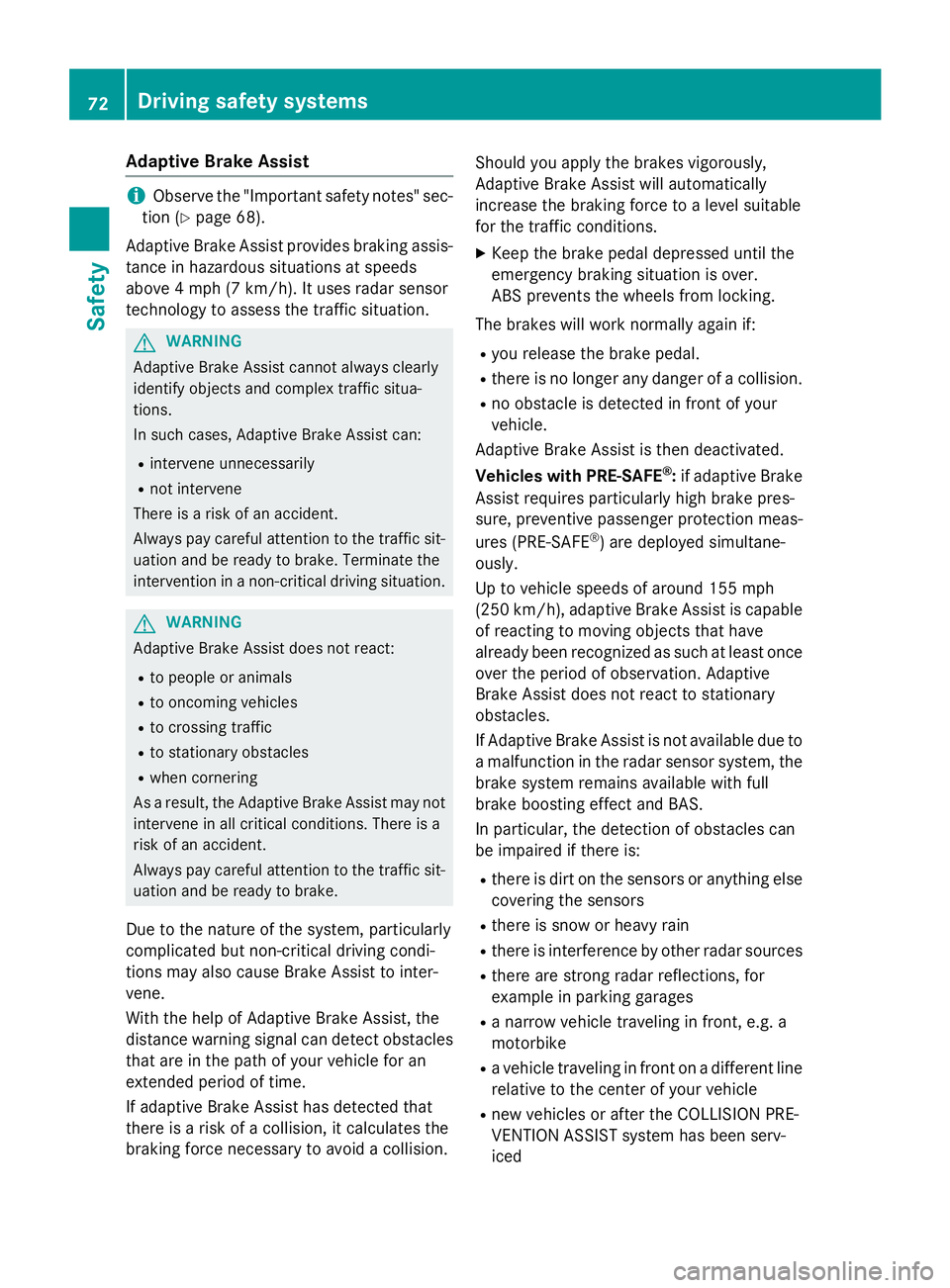
Adaptive Brake Assist
i Obs erv e th e "Importan t safet y notes" sec -
tion ( Y
page 68) .
Adaptive Brake Assis t provide s braking assis-
tance in hazardous situation s at speeds
abov e 4 mph (7 km/h). It uses radar sensor
technology to assess th e traffic situation .
G WARNIN G
Adaptive Brake Assis t canno t always clearly
identify objects and complex traffic situa-
tions.
In suc h cases, Adaptive Brake Assis t can :R
interven e unnecessarilyR
no t interven e
There is a ris k of an accident.
Always pay careful attention to th e traffic sit -
uation and be read y to brake. Terminate th e
intervention in a non-critical drivin g situation .
G WARNIN G
Adaptive Brake Assis t does no t react:R
to people or animals R
to oncomin g vehiclesR
to crossing traffic R
to stationary obstacles R
when cornering
As a result , th e Adaptive Brake Assis t may no t
interven e in all critical conditions. There is a
ris k of an accident.
Always pay careful attention to th e traffic sit -
uation and be read y to brake.
Due to th e nature of th e system, particularly
complicated but non-critical driving condi-
tion s may also caus e Brake Assis t to inter-
vene.
Wit h th e help of Adaptive Brake Assist, th e
distanc e warning signal can detec t obstacles
that are in th e pat h of your vehicl e for an
extended period of time.
If adaptive Brake Assis t has detecte d that
there is a ris k of a collision , it calculates th e
braking force necessar y to avoi d a collision . Should you apply th e brakes vigorously,
Adaptive Brake As sist will automatically
increas e th e braking force to a level suitable
for th e traffic conditions. X
Kee p th e brak e pedal depressed until th e
emergenc y braking situation is over.
AB S prevents th e wheels from locking .
The brakes will wor k normally again if: R
you release th e brak e pedal .R
there is no longer any danger of a collision .R
no obstacle is detecte d in fron t of your
vehicle.
Adaptive Brake As sist is then deactivated.
Vehicles wit h PRE-SAFE ®
: if adaptive Brake
Assis t require s particularly high brak e pre s-
sure, preventive passenger protection meas -
ures (PRE-SAF E ®
) are deployed sim ultane -
ously.
Up to vehicl e speeds of aroun d 15 5 mph
(25 0 km/h), adaptive Brake Assis t is capable
of reacting to moving objects that hav e
already been recognized as suc h at least once
ove r th e period of observation . Adaptive
Brake Assis t does no t reac t to st ationary
obstacles.
If Adaptive Brake As sist is no t available due to
a malfunction in th e radar sensor system, th e
brak e system remain s available wit h full
brak e boosting effec t and BAS.
In particular, th e detection of obstacles can
be impaire d if there is: R
there is dirt on th e sensors or anythin g else
covering th e sensors R
there is sn ow or heav y rainR
there is interferenc e by other radar source sR
there are st ron g radar reflections, for
exampl e in parking garages R
a narrow vehicl e traveling in front, e.g. a
motorbik e R
a vehicl e traveling in fron t on a differen t lin e
relative to th e center of your vehicl eR
ne w vehicles or after th e COLLISION PRE -
VE NTION ASSIST system has been ser v-
ice d72
Driving safety systems
Safety
Page 78 of 462
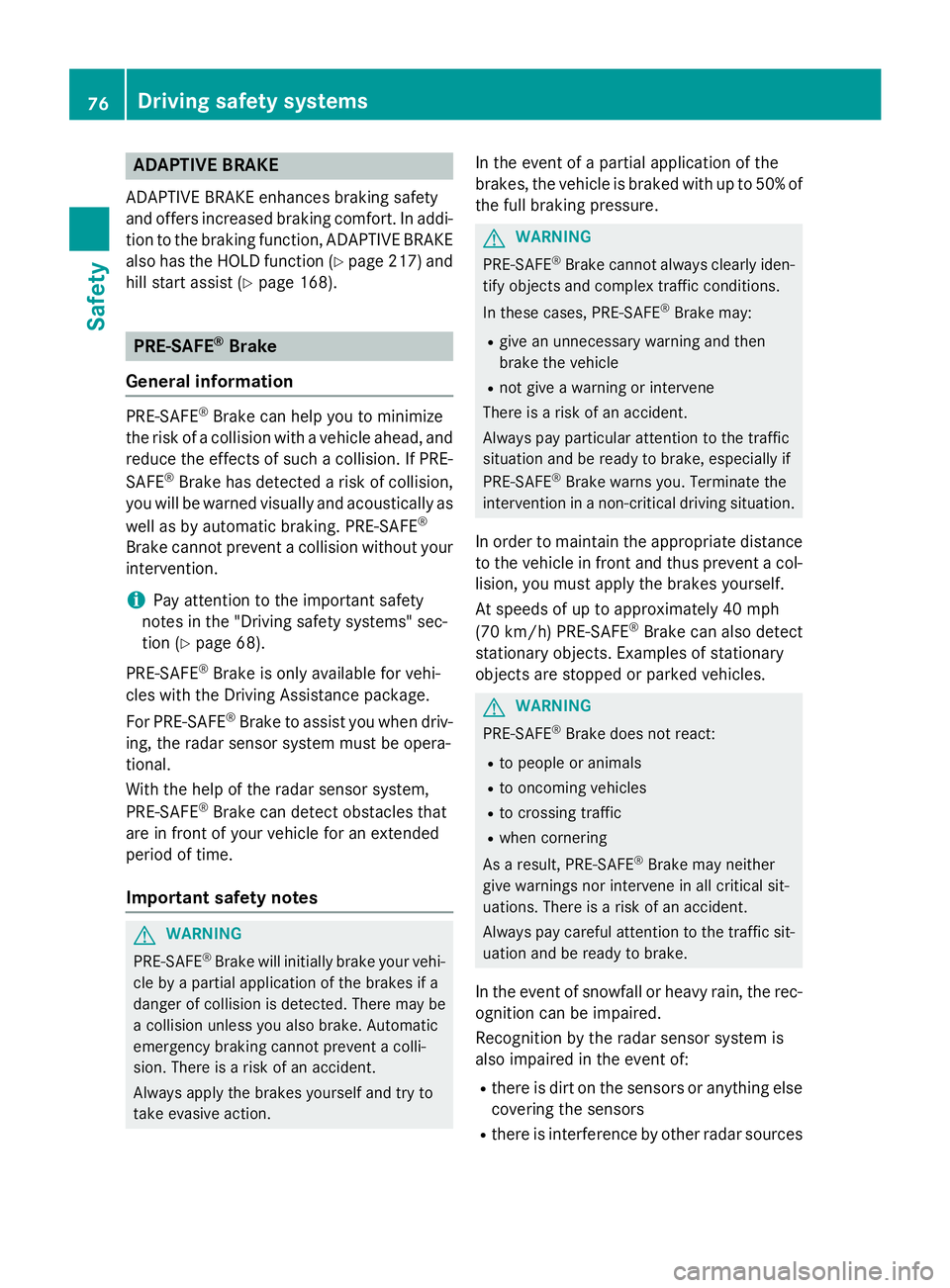
ADAPTIVE BRAKEADAPTIV E BRAKE enhance s braking safet y
and offers increased braking comfort . In addi-
tion to th e braking function , ADAPTIV E BRAKE
also has th e HOLD function ( Y
page 217) and
hill start assist ( Y
page 168).
PRE-SAFE ®
Brake
Gene ra l inf orm ationPRE-SAF E ®
Brake can help you to minimiz e
th e ris k of a collision wit h a vehicl e ahead , and
reduce th e effects of suc h a collision . If PRE -
SAFE ®
Brake has detecte d a ris k of collision ,
you will be warned visually and acoustically as
well as by automatic braking . PRE-SAF E ®
Brake canno t preven t a collision without your
intervention .
i Pay attention to th e important safet y
note s in th e "Drivin g safet y systems " sec -
tion ( Y
page 68) .
PRE ‑ S AF E ®
Brake is only available for vehi-
cle s wit h th e Drivin g Assistance package.
Fo r PRE-SAF E ®
Brake to assist you when driv -
ing , th e radar sensor system mus t be opera-
tional.
Wit h th e help of th e radar sensor system,
PRE-SAF E ®
Brake can detec t obstacles that
are in fron t of your vehicl e for an extended
period of time.
Import ant safety notes
G WARNIN G
PRE-SAF E ®
Brake will initially brak e your vehi-
cle by a partial application of th e brakes if a
danger of collision is detected. There may be
a collision unless you also brake. Automatic
emergenc y braking canno t preven t a colli-
sion . There is a ris k of an accident.
Always apply th e brakes yourself and tr y to
tak e evasive action . In th e event of a partial application of th e
brakes, th e vehicl e is braked wit h up to 50 % of
th e full braking pressure.
G WARNIN G
PRE-SAF E ®
Brake canno t always clearly iden -
tify objects and comple x traffic conditions.
In these cases, PRE-SAF E ®
Brake may:R
giv e an unnecessary warning and then
brak e th e vehicl e R
no t giv e a warning or interven e
There is a ris k of an accident.
Always pay particular attention to th e traffic
situation and be read y to brake, especially if
PRE-SAF E ®
Brake warn s you. Terminate th e
intervention in a non-critical drivin g situation .
In order to maintai n th e appropriat e distanc e
to th e vehicl e in fron t and thus preven t a col-
lision, you mus t apply th e brakes yourself .
At speeds of up to approximately 40 mph
(70 km/h ) PRE-SAF E ®
Brake can also detec t
stationary objects . Examples of stationary
objects are st oppe d or parked vehicles.
G WARNIN G
PRE-SAF E ®
Brake does no t react:R
to people or animals R
to oncomin g vehicles R
to crossing traffic R
when cornering
As a result , PRE-SAF E ®
Brake may neither
giv e warning s no r interven e in all critical sit -
uations. There is a ris k of an accident.
Always pay careful attention to th e traffic sit -
uation and be read y to brake.
In th e event of snowfall or heav y rain , th e rec -
ognition can be impaired.
Recognition by th e radar sensor system is
also impaire d in th e event of: R
there is dirt on th e sensors or anythin g else
covering th e sensors R
there is interferenc e by other radar source s76
Driving safety systems
Safety
Page 170 of 462
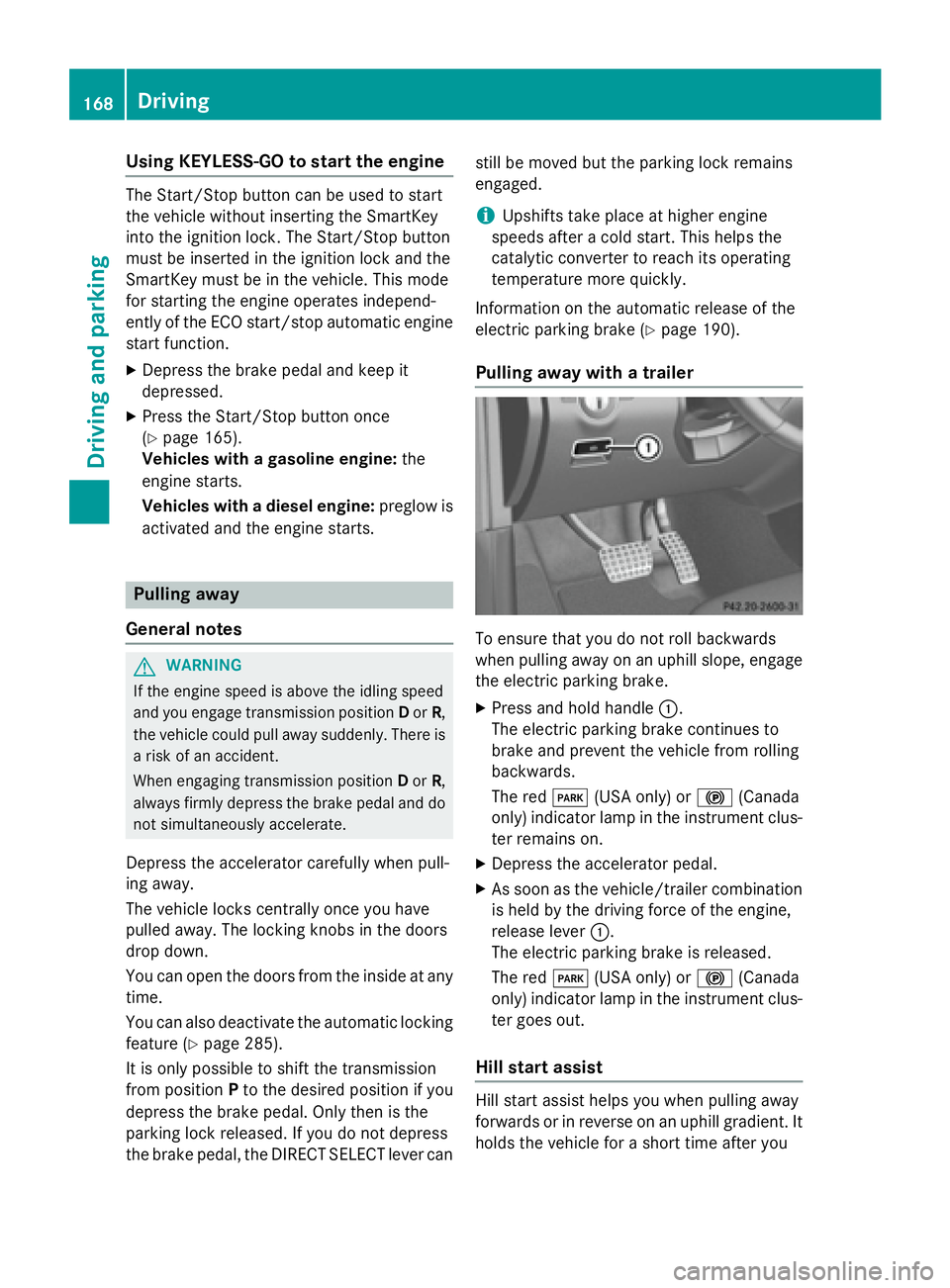
Using KEYLESS-GO to start the engine The Start/Stop button can be used to start
the vehicle without inserting the SmartKey
into the ignition lock. The Start/Stop button
must be inserted in the ignition lock and the
SmartKey must be in the vehicle. This mode
for starting the engine operates independ-
ently of the ECO start/stop automatic engine
start function. X
Depress the brake pedal and keep it
depressed. X
Press the Start/Stop button once
( Y
page 165).
Vehicles with a gasoline engine: the
engine starts.
Vehicles with a diesel engine: preglow is
activated and the engine starts.
Pulling away
General notes
G WARNING
If the engine speed is above the idling speed
and you engage transmission position D or R ,
the vehicle could pull away suddenly. There is
a risk of an accident.
When engaging transmission position D or R ,
always firmly depress the brake pedal and do
not simultaneously accelerate.
Depress the accelerator carefully when pull-
ing away.
The vehicle locks centrally once you have
pulled away. The locking knobs in the doors
drop down.
You can open the doors from the inside at any
time.
You can also deactivate the automatic locking
feature ( Y
page 285).
It is only possible to shift the transmission
from position P to the desired position if you
depress the brake pedal. Only then is the
parking lock released. If you do not depress
the brake pedal, the DIRECT SELECT lever can still be moved but the parking lock remains
engaged.
i Upshifts take place at higher engine
speeds after a cold start. This helps the
catalytic converter to reach its operating
temperature more quickly.
Information on the automatic release of the
electric parking brake ( Y
page 190).
Pulling away with a trailer
To ensure that you do not roll backwards
when pulling away on an uphill slope, engage
the electric parking brake. X
Press and hold handle �C .
The electric parking brake continues to
brake and prevent the vehicle from rolling
backwards.
The red �I (USA only) or �$ (Canada
only) indicator lamp in the instrument clus-
ter remains on. X
Depress the accelerator pedal. X
As soon as the vehicle/trailer combination
is held by the driving force of the engine,
release lever �C .
The electric parking brake is released.
The red �I (USA only) or �$ (Canada
only) indicator lamp in the instrument clus-
ter goes out.
Hill start assist
Hill start assist helps you when pulling away
forwards or in reverse on an uphill gradient. It
holds the vehicle for a short time after you168
Driving
Driving and parking
Page 171 of 462
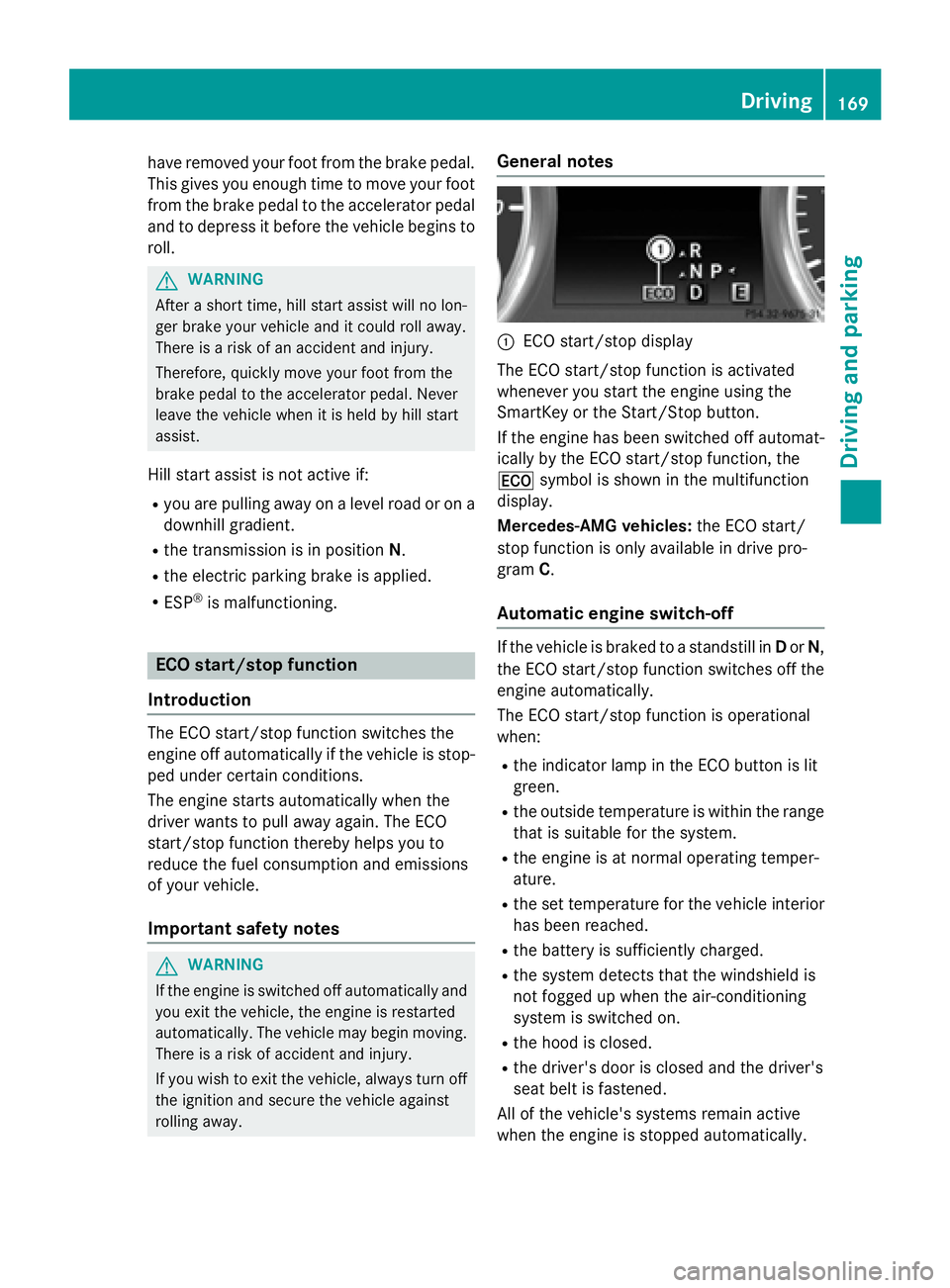
have removed your foot from the brake pedal.
This gives you enough time to move your foot
from the brake pedal to the accelerator pedal
and to depress it before the vehicle begins to
roll.
G WARNING
After a short time, hill start assist will no lon-
ger brake your vehicle and it could roll away.
There is a risk of an accident and injury.
Therefore, quickly move your foot from the
brake pedal to the accelerator pedal. Never
leave the vehicle when it is held by hill start
assist.
Hill start assist is not active if: R
you are pulling away on a level road or on a
downhill gradient. R
the transmission is in position N .R
the electric parking brake is applied. R
ESP ®
is malfunctioning.
ECO start/stop function
Introduction
The ECO start/stop function switches the
engine off automatically if the vehicle is stop-
ped under certain conditions.
The engine starts automatically when the
driver wants to pull away again. The ECO
start/stop function thereby helps you to
reduce the fuel consumption and emissions
of your vehicle.
Important safety notes
G WARNING
If the engine is switched off automatically and
you exit the vehicle, the engine is restarted
automatically. The vehicle may begin moving.
There is a risk of accident and injury.
If you wish to exit the vehicle, always turn off
the ignition and secure the vehicle against
rolling away. General notes
�C
ECO start/stop display
The ECO start/stop function is activated
whenever you start the engine using the
SmartKey or the Start/Stop button.
If the engine has been switched off automat-
ically by the ECO start/stop function, the
�
Page 181 of 462
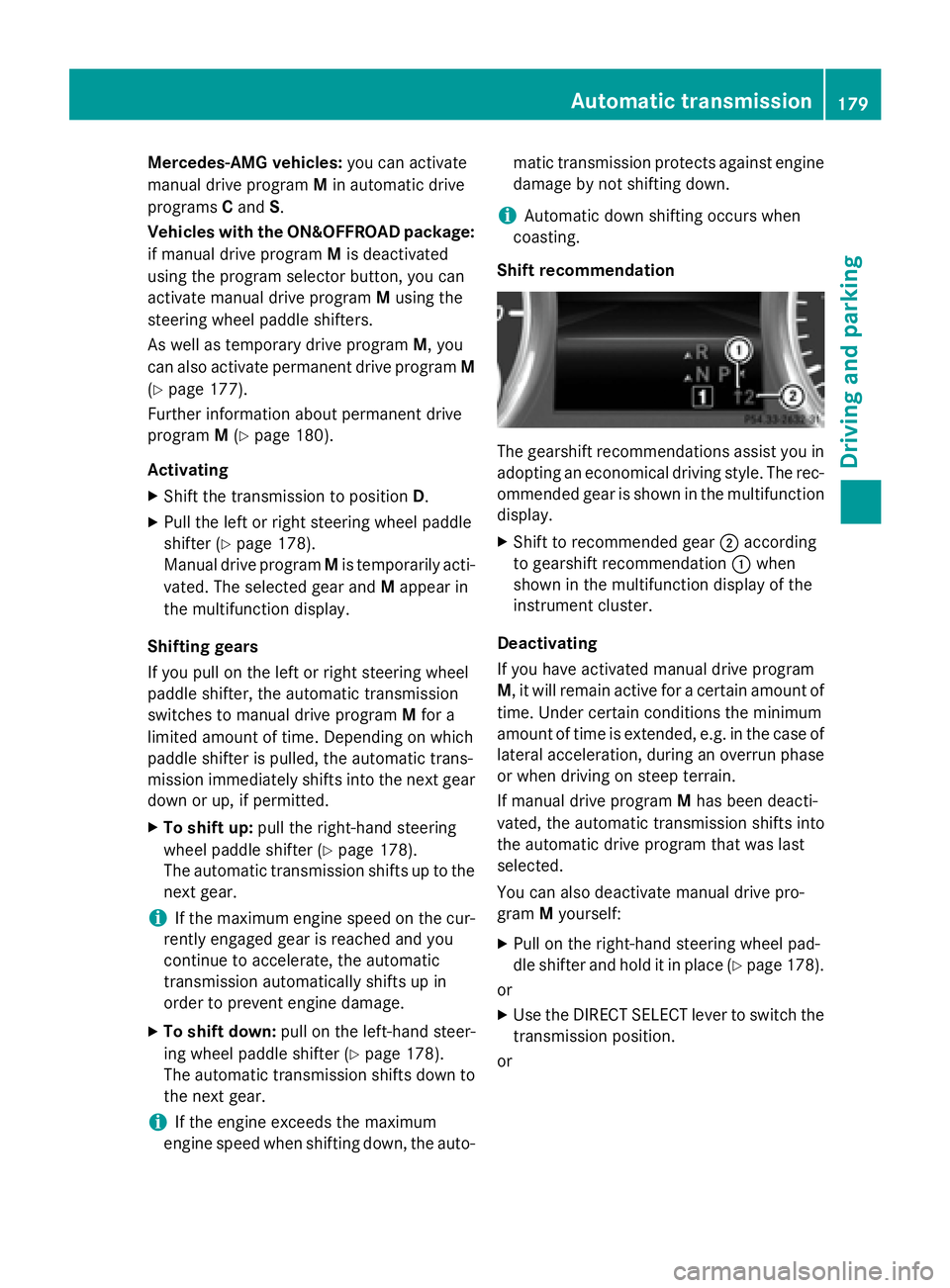
Mercedes-AMG vehicles: you can activate
manual drive program M in automatic drive
programs C and S .
Vehicles with the ON&OFFROAD package:
if manual drive program M is deactivated
using the program selector button, you can
activate manual drive program M using the
steering wheel paddle shifters.
As well as temporary drive program M , you
can also activate permanent drive program M
( Y
page 177).
Further information about permanent drive
program M ( Y
page 180).
Activating X
Shift the transmission to position D .X
Pull the left or right steering wheel paddle
shifter ( Y
page 178).
Manual drive program M is temporarily acti-
vated. The selected gear and M appear in
the multifunction display.
Shifting gears
If you pull on the left or right steering wheel
paddle shifter, the automatic transmission
switches to manual drive program M for a
limited amount of time. Depending on which
paddle shifter is pulled, the automatic trans-
mission immediately shifts into the next gear
down or up, if permitted. X
To shift up: pull the right-hand steering
wheel paddle shifter ( Y
page 178).
The automatic transmission shifts up to the
next gear.
i If the maximum engine speed on the cur-
rently engaged gear is reached and you
continue to accelerate, the automatic
transmission automatically shifts up in
order to prevent engine damage. X
To shift down: pull on the left-hand steer-
ing wheel paddle shifter ( Y
page 178).
The automatic transmission shifts down to
the next gear.
i If the engine exceeds the maximum
engine speed when shifting down, the auto- matic transmission protects against engine
damage by not shifting down.
i Automatic down shifting occurs when
coasting.
Shift recommendation
The gearshift recommendations assist you in
adopting an economical driving style. The rec-
ommended gear is shown in the multifunction
display. X
Shift to recommended gear �D according
to gearshift recommendation �C when
shown in the multifunction display of the
instrument cluster.
Deactivating
If you have activated manual drive program
M , it will remain active for a certain amount of
time. Under certain conditions the minimum
amount of time is extended, e.g. in the case of
lateral acceleration, during an overrun phase
or when driving on steep terrain.
If manual drive program M has been deacti-
vated, the automatic transmission shifts into
the automatic drive program that was last
selected.
You can also deactivate manual drive pro-
gram M yourself: X
Pull on the right-hand steering wheel pad-
dle shifter and hold it in place ( Y
page 178).
or X
Use the DIRECT SELECT lever to switch the
transmission position.
orAutomatic transmission 179
Driving and parking Z